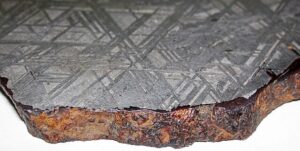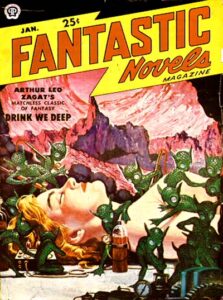
A stony-iron pallasite Springwater’s slab: 3,9 gram, 37,9 х 28,6 х 1,6 mm, 15 June 2020, photo OksanaStich.
Peter inherited a small collection of meteorites from his father, Bob. The meteorites sat on a shelf in Bob’s home for many years, before being boxed up after he passed away. While doing some downsizing prompted by a home renovation, Peter found the box and opened it. Peter vaguely remembered a story that Bob found his first meteorite the day after observing a fireball in the sky. He wondered if one of the meteorites in the box was that very find, and decided to learn more about the meteorites in his dad’s collection.
As it turns out, meteorites have their own aficionados who collect them according to their purported extraterrestrial origins as well as their find spots here on earth. As always, nomenclature is important. Meteoroids are space rocks, which can be small dust particles or large asteroids. Meteors are the fireballs or “shooting stars” that are observed when meteoroids have entered the atmosphere and burn up. Meteorites are the fragments that survive reentry and hit the ground. Usually, they fall into the sea or some uninhabited area, but every so often the press reports a meteorite crashing through the roof of someone’s home.

Kossuth Meteorite, Octahedrite from the Asteroid Belt between Mars and Jupiter. Rusted edge of a polished and acid-etched slice; private collection.
While most meteors come from asteroids, some rare ones originated from the Moon or Mars. Before arriving here, they were first ejected from the lunar or Martian surface into outer space after an asteroid strike, before being captured by our own gravity and falling to our own earth.
But how do you tell a meteorite is really a space rock and not just an ordinary rock, or a “meteorwrong” as some in the trade say? Well, of course, it’s not that simple, but meteorites typically exhibit common features. Most meteorites will have significant iron content and will be attracted to a magnet. The iron content also makes them feel heavy for their size or dense. Recent arrivals typically display a shiny black rind called “fusion crust” that is evidence of their entry into our atmosphere. These markings weather off over time. Meteorites can also display other surface features based on their composition, including metallic flakes, and small, colorful grain like spheres called chondrules. Meteorites often exhibit a rusty patina from their iron content weathering. Verifying that a meteorite is one of the few that originate from the Moon or Mars is much more complicated, typically involving scientific tests to determine levels of cosmic ray exposure.

Meteorite in the American Museum of Natural History, New York City, October 5, 2023, photo Jakub Hałun, CCA 4.0.
In the old days, searchers had to rely on their own powers of observation to find meteorites, but today metal detectors are employed to locate meteorites based on their iron content. Of course, searching for anything raises legal issues, but meteorite collectors benefit from the fact that space rocks are not treated the same way as archaeological or ethnological material. After all, they are not cultural heritage associated with the people of a modern nation state, and, at least for the time being, no aliens have stepped forward to demand their repatriation to the Moon, Mars, or some other Universe.
Instead, in addition to bans on or limitations on the use of metal detectors, more general regulations covering “finds” typically govern any disputes between finders and landowners. In the U.S., meteorites generally are considered the property of the landowner. The U.S. Government allows finders to retain meteorites found on most federal land as keepsakes. A license must be procured for any commercial exploitation of meteorite finds, and it is forbidden to extract meteorites from National Parks.
Rules may vary in other countries. Recently in Sweden, geologists were pitted against a landowner concerning ownership of a 30-pound fresh fall meteorite. The geologists located the meteorite after a hunt prompted by imagery taken from scientific cameras used to track the trajectories of meteoroids as they enter the atmosphere. The geologists located the space rock after a search based on that trajectory, removing the meteorite so that it could be displayed in the Swedish Museum of Natural History. After the geologists went public with their find, the landowner contacted the museum, demanding its return. A legal case ensued.

NASA’s Curiosity Mars rover captured this image of an iron-nickel meteorite nicknamed “Cacao”, Jan, 28, 2023, NASA/JPL-Caltech/MSSS, public domain.
A lower court awarded the meteorite to the geologists under customary Swedish law that grants rights to public access in nature areas and with it an ability to forage on the land. That Court concluded that “a newly fallen meteorite is not part of the property on which it has landed.” An appeals court, however, overturned the ruling, instead concluding that the large meteorite should be treated as an immovable object subject to the landowner’s ownership. Underlying the dispute was the academics’ fear that other meteorites from the same meteor could be spirited out of the country by foreign dealers or collectors and thus “lost to science.” Does that sound familiar to those who collect archaeological or ethnological objects?
And what about Peter and his dad’s meteorites? After taking a magnet to them, and comparing their weight and looking to examples displayed on the “Suspected Meteorite Education” website, Peter had some doubts about their extraterrestrial origin, wondering if they were actually “meteorwrongs.” Anyway, it was fun for Peter to learn more about meteorites, and he thought to himself how his dad would have enjoyed learning more too, even if his research raised the same doubts.
* Peter K. Tompa is a semi-retired lawyer who resides in Washington, D.C. He has written extensively about cultural heritage issues, particularly those of interest to the numismatic trade. Peter contributed to Who Owns the Past?” (K. Fitz Gibbon, ed. Rutgers 2005). He formerly served as executive director of the Global Heritage Alliance and now is a member of its board of directors. He currently serves as Executive Director for the International Association of Professional Numismatists.
This article is a public resource for general information and opinions about cultural property issues and is not intended to be a source for legal advice. Any factual patterns discussed may or may not be inspired by real people and events. The opinions stated in this article are the author’s alone and should not be attributed to any affiliated organization.
Next Installment: “Liberated” Treasures Return Home
Further Reading:
More About Meteorites:
Meteors and Meteorites, NASA website
Suspected Meteorite Education, Aerolite Meteorite website

Cover of the January 1951 issue of Fantastic Novels magazine, photo13 June 2015. Wikipedia Commons.
Lunar Meteorites:
Lunar Meteorites, Some Meteorite Information, Washington University in St. Louis
Near Misses:
John Yoon and Vjosa Isai, Meteorite Crashes Through Ceiling and Lands on Woman’s Bed, The New York Times (Oct. 14, 2021 updated Oct. 21, 2021)
Ownership issues:
64th Annual Meteoritical Society Meeting (2001)
Bureau of Land Management, FAQs on Meteorites on Public Land (undated)
Christina Anderson, A Rock Fell From Space Into Sweden. Who Owns It on Earth? New York Times (March 22, 2024 updated March 27, 2024)
 A meteorite on the blue ice field in the Miller Range, Antarctica. December 19, 2015, NASA, image credit: Nina Lanza, Public domain.
A meteorite on the blue ice field in the Miller Range, Antarctica. December 19, 2015, NASA, image credit: Nina Lanza, Public domain. 

